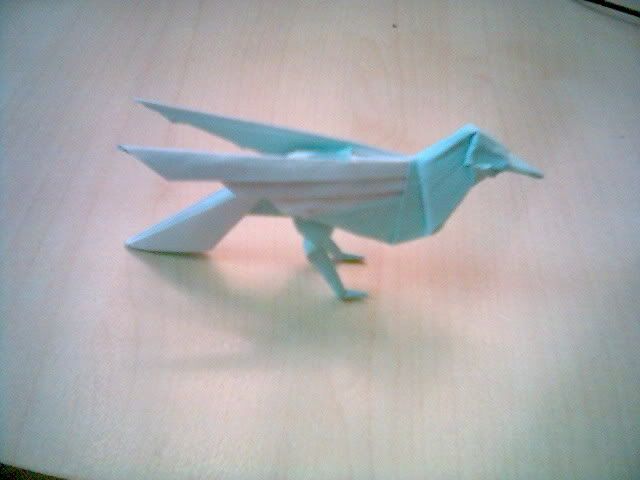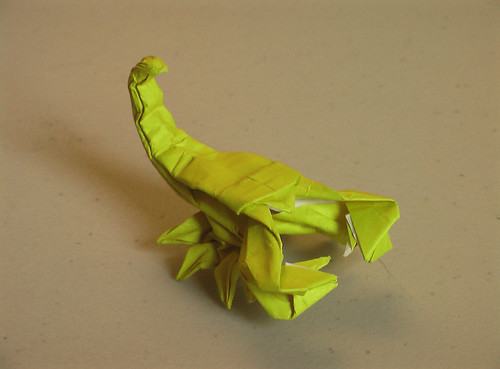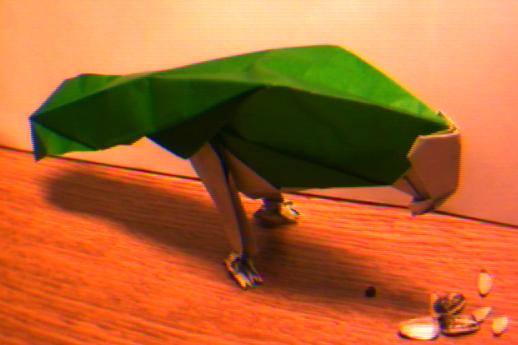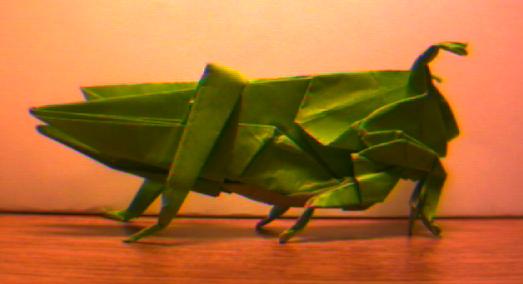Wednesday, September 1, 2010
by vntopic
| SONG BIRD | |||
| Author | R.J.Lang | |
| In Book | THE COMPLETE BOOK OF ORIGAMI | ||
| Page Book | 25-27 | ||
| Steps | 26 | ||
| Level | NORMAL | ||
| Style | BIRD | ||
| Quality view | GOOD | ||
| Order ID | 27 | ||
| Cover Link | Click to Cover | ||
by vntopic
| SHARK | |||
| Author | R.J.Lang | |
| In Book | THE COMPLETE BOOK OF ORIGAMI | ||
| Page Book | 15-16 | ||
| Steps | 22 | ||
| Level | EASY | ||
| Style | FISH | ||
| Quality view | GOOD | ||
| Order ID | 26 | ||
| Cover Link | Click to Cover | ||
by vntopic
| SCORPION | |||
| Author | R.J.Lang | |
| In Book | THE COMPLETE BOOK OF ORIGAMI | ||
| Page Book | 91-96 | ||
| Steps | 41 | ||
| Level | INTERMEDIARE | ||
| Style | INSECT | ||
| Quality view | GOOD | ||
| Order ID | 23 | ||
| Cover Link | Click to Cover | ||
by vntopic
| SEATED LADY | |||
| Author | R.J.Lang | |
| In Book | THE COMPLETE BOOK OF ORIGAMI | ||
| Page Book | 20-21 | ||
| Steps | 18 | ||
| Level | EASY | ||
| Style | HUMAN | ||
| Quality view | GOOD | ||
| Order ID | 25 | ||
| Cover Link | Click to Cover | ||
by vntopic
| PIANIST | |||
| Author | R.J.Lang | |
| In Book | THE COMPLETE BOOK OF ORIGAMI | ||
| Page Book | 133-144 | ||
| Steps | 84 | ||
| Level | COMPLEX | ||
| Style | HUMAN | ||
| Quality view | GOOD | ||
| Order ID | 20 | ||
| Cover Link | Click to Cover | ||
by vntopic
| PEGASUS | |||
| Author | R.J.Lang | ||
| In Book | THE COMPLETE BOOK OF ORIGAMI | ||
| Page Book | 53-55 | ||
| Steps | 22 | ||
| Level | EASY | ||
| Style | ANIMAL | ||
| Quality view | GOOD | ||
| Order ID | 19 | ||
| Cover Link | Click to Cover | ||
by vntopic
| PARROT | |||
| Author | R.J.Lang | |
| In Book | THE COMPLETE BOOK OF ORIGAMI | ||
| Page Book | 74-78 | ||
| Steps | 40 | ||
| Level | EASY | ||
| Style | ANIMAL | ||
| Quality view | GOOD | ||
| Order ID | 18 | ||
| Cover Link | Click to Cover | ||
by vntopic
| NUN | |||
| Author | R.J.Lang | ||
| In Book | THE COMPLETE BOOK OF ORIGAMI | ||
| Page Book | 22-23 | ||
| Steps | 15 | ||
| Level | EASY | ||
| Style | HUMAN | ||
| Quality view | GOOD | ||
| Order ID | 17 | ||
| Cover Link | Click to Cover | ||
by vntopic
| KING TUT | |||
| Author | R.J.Lang | |
| In Book | THE COMPLETE BOOK OF ORIGAMI | ||
| Page Book | 28-30 | ||
| Steps | 24 | ||
| Level | EASY | ||
| Style | FANTASY | ||
| Quality view | GOOD | ||
| Order ID | 15 | ||
| Cover Link | Click to Cover | ||
by vntopic
| GRASSHOPPER | |||
| Author | R.J.Lang | |
| In Book | THE COMPLETE BOOK OF ORIGAMI | ||
| Page Book | 41-44 | ||
| Steps | 29 | ||
| Level | INTERMEDIARE | ||
| Style | INSECT | ||
| Quality view | GOOD | ||
| Order ID | 13 | ||
| Cover Link | Click to Cover | ||
by vntopic
| KANGAROO | |||
| Author | R.J.Lang | |
| In Book | THE COMPLETE BOOK OF ORIGAMI | ||
| Page Book | 17-18 | ||
| Steps | 24 | ||
| Level | EASY | ||
| Style | ANIMAL | ||
| Quality view | GOOD | ||
| Order ID | 14 | ||
| Cover Link | Click to Cover | ||
by vntopic
| GERBIL | |||
| Author | R.J.Lang | ||
| In Book | THE COMPLETE BOOK OF ORIGAMI | ||
| Page Book | 32-33 | ||
| Steps | 15 | ||
| Level | EASY | ||
| Style | ANIMAL | ||
| Quality view | GOOD | ||
| Order ID | 12 | ||
| Cover Link | Click to Cover | ||
by vntopic
| FISH | |||
| Author | R.J.Lang | |
| In Book | THE COMPLETE BOOK OF ORIGAMI | ||
| Page Book | 09-10 | ||
| Steps | 18 | ||
| Level | EASY | ||
| Style | FISH | ||
| Quality view | GOOD | ||
| Order ID | 11 | ||
| Cover Link | Click to Cover | ||
by vntopic
| ELEPHANT | |||
| Author | R.J.Lang | |
| In Book | THE COMPLETE BOOK OF ORIGAMI | ||
| Page Book | 68-73 | ||
| Steps | 37 | ||
| Level | INTERMEDIARE | ||
| Style | ANIMAL | ||
| Quality view | GOOD | ||
| Order ID | 10 | ||
| Cover Link | Click to Cover | ||
by vntopic
| DRAGON FLY | |||
| Author | R.J.Lang | |
| In Book | THE COMPLETE BOOK OF ORIGAMI | ||
| Page Book | 34-36 | ||
| Steps | 31 | ||
| Level | EASY | ||
| Style | ANIMAL | ||
| Quality view | GOOD | ||
| Order ID | 9 | ||
| Cover Link | Click to Cover | ||
by vntopic
| DIMETRODON | |||
| Author | R.J.Lang | ||
| In Book | THE COMPLETE BOOK OF ORIGAMI | ||
| Page Book | 45-47 | ||
| Steps | 20 | ||
| Level | EASY | ||
| Style | ANIMAL | ||
| Quality view | GOOD | ||
| Order ID | 8 | ||
| Cover Link | Click to Cover | ||
by vntopic
| DEER | |||
| Author | R.J.Lang | |
| In Book | THE COMPLETE BOOKOF ORIGAMI | ||
| Page Book | 48-52 | ||
| Steps | 42 | ||
| Level | INTERMEDIARE | ||
| Style | ANIMAL | ||
| Quality view | GOOD | ||
| Order ID | 7 | ||
| Cover Link | Click to Cover | ||
by vntopic
| CUCKOO CLOCK | |||
| Author | R.J.Lang | |
| In Book | THE COMPLETE BOOKOF ORIGAMI | ||
| Page Book | 145-154 | ||
| Steps | 79 | ||
| Level | COMPLEX | ||
| Style | OBJECT | ||
| Quality view | GOOD | ||
| Order ID | 6 | ||
| Cover Link | Click to Cover | ||
by vntopic
| CICADA | |||
| Author | R.J.Lang | |
| In Book | THE COMPLETE BOOKOF ORIGAMI | ||
| Page Book | 104-111 | ||
| Steps | 75 | ||
| Level | COMPLEX | ||
| Style | INSECT | ||
| Quality view | GOOD | ||
| Order ID | 5 | ||
| Cover Link | Click to Cover | ||
by vntopic
| CAP | |||
| Author | R.J.Lang | |
| In Book | THE COMPLETE BOOKOF ORIGAMI | ||
| Page Book | 13-14 | ||
| Steps | 19 | ||
| Level | EASY | ||
| Style | OBJECT | ||
| Quality view | GOOD | ||
| Order ID | 4 | ||
| Cover Link | Click to Cover | ||
by vntopic
| BIPLANE | |||
| Author | R.J.Lang | |
| In Book | THE COMPLETE BOOKOF ORIGAMI | ||
| Page Book | 79-84 | ||
| Steps | 31 | ||
| Level | NORMAL | ||
| Style | TRANSPORT | ||
| Quality view | GOOD | ||
| Order ID | 3 | ||
| Cover Link | Click to Cover | ||
by vntopic
| Author | R.J.Lang | |
| In Book | THE COMPLETE BOOKOF ORIGAMI | ||
| Page Book | 127-152 | ||
| Steps | 50 | ||
| Level | NORMAL | ||
| Style | HUMAN | ||
| Quality view | GOOD | ||
| Order ID | 2 | ||
| Cover Link | Click to Cover |
by vntopic
| BALD EAGLE | |||
| Author | R.J.Lang | ||
| In Book | THE COMPLETE BOOKOF ORIGAMI | ||
| Page Book | 37-40 | ||
| Steps | 31 | ||
| Level | EASY | ||
| Style | ANIMAL | ||
| Quality view | GOOD | ||
| Order ID | 1 | ||
| Cover Link | Click to Cover | ||
by vntopic
The complete book of origami
By Robert J. Lang
By Robert J. Lang

Robert J. Lang is one of the world's leading folders. This book shows
some of his early work, progressing from the very simple to super-complex designs.
The thing I don't like about this book, is the fact that the written instruction are separated from the drawn diagrams - which makes the flow less comfortable.
Other than that - it's one of those "must have" books, due to to the challenge and intrigue of the models.
Diagram by The complete book of origami
some of his early work, progressing from the very simple to super-complex designs.
The thing I don't like about this book, is the fact that the written instruction are separated from the drawn diagrams - which makes the flow less comfortable.
Other than that - it's one of those "must have" books, due to to the challenge and intrigue of the models.
Diagram by The complete book of origami
by vntopic
Yoshihide Momotani

Yoshihide Momotani (桃 谷 好 英, Yoshihide Momotani, born in the late 1920s) is a Japanese biologist.
It is also known as an important figure in origami, the creator of many models folded paper (some with his wife Sumiko ). Among his achievements, he managed to create complex shapes, eg, plants, dolls house , atoms and molecules. Momotani used these last two types of folding during the chemistry course for first year students to enable them to develop the organization and properties of these elements.
His patterns is very copious and manifold.
he still has paper model research grandfather folding model turgescent method, among them stills- papercraft.
- Easy Dinosaur Origami
- Birds of Japan in Origami (Origami Nihon no Yachou)
- Flowers of Japan in Origami (Origami Nihon Hana no Tabi)
- Trick Origami
- Flying Bird Origami 1
- Flying Bird Origami 2
- Fantastic Origami: The Treasure Island
- Early Spring flowers of Origami
- Molecular Models with Origami
- Lay Out a Garden with Origami
- Dolls House with Origami
- Incised Origami
- Insectology
- Origami Amusement park
- Origami Cards
- Origami Dinosaurs
- Origami Flower Ball
- Origami of Ships
- Origami of Planes& Automobiles
- Origami of insects
- Origami Magic Tricks
- Origami Alpine Flowers (Yama no Hana Origami)
- Origami Wild Flowers (Kurashi o Kazaru No no Hana Origami)
- Origami Vehicles 1
- Origami Vehicles 2
- Simple Animal Origami 1 (đồng tác giả với Eiki Momotani - cùng họ Momotani)
- Four seasons - winter flower (đồng tác giả với Sumiko Momotani - cùng họ Momotani)
- Four seasons - Spring flower (đồng tác giả với Sumiko Momotani - cùng họ Momotani)
- Four seasons - Autumn flower (đồng tác giả với Sumiko Momotani - cùng họ Momotani)
- Four seasons - Summer flower (đồng tác giả với Sumiko Momotani - cùng họ Momotani)
- Sutekina Origami 1: Oningyo (Origami dolls)
- Sutekina Origami 2: Dobutsu (Origami Animals)
- Sutekina Origami 3: (Flowers and insects.)
- Sutekina Origami 4
- Origami of Japanese Legends
- Origami Dogs (New Origami Land 34)
- Origami Equipments on a Table (New Origami Land 36)
- Origami Art in Casual Life (New Origami Land 37)

Yoshihide Momotani (桃 谷 好 英, Yoshihide Momotani, born in the late 1920s) is a Japanese biologist.
It is also known as an important figure in origami, the creator of many models folded paper (some with his wife Sumiko ). Among his achievements, he managed to create complex shapes, eg, plants, dolls house , atoms and molecules. Momotani used these last two types of folding during the chemistry course for first year students to enable them to develop the organization and properties of these elements.
His patterns is very copious and manifold.
he still has paper model research grandfather folding model turgescent method, among them stills- papercraft.
 HÔRYÛJI của Dr. Yoshihide Momotani và vợ Ms. Sumiko Momotani  BYÔDÔIN Dr. Yoshihide Momotani  USAGI Dr. Yoshihide Momotani  LINDÔ Dr. Yoshihide Momotani |
- Birds of Japan in Origami (Origami Nihon no Yachou)
- Flowers of Japan in Origami (Origami Nihon Hana no Tabi)
- Trick Origami
- Flying Bird Origami 1
- Flying Bird Origami 2
- Fantastic Origami: The Treasure Island
- Early Spring flowers of Origami
- Molecular Models with Origami
- Lay Out a Garden with Origami
- Dolls House with Origami
- Incised Origami
- Insectology
- Origami Amusement park
- Origami Cards
- Origami Dinosaurs
- Origami Flower Ball
- Origami of Ships
- Origami of Planes& Automobiles
- Origami of insects
- Origami Magic Tricks
- Origami Alpine Flowers (Yama no Hana Origami)
- Origami Wild Flowers (Kurashi o Kazaru No no Hana Origami)
- Origami Vehicles 1
- Origami Vehicles 2
- Simple Animal Origami 1 (đồng tác giả với Eiki Momotani - cùng họ Momotani)
- Four seasons - winter flower (đồng tác giả với Sumiko Momotani - cùng họ Momotani)
- Four seasons - Spring flower (đồng tác giả với Sumiko Momotani - cùng họ Momotani)
- Four seasons - Autumn flower (đồng tác giả với Sumiko Momotani - cùng họ Momotani)
- Four seasons - Summer flower (đồng tác giả với Sumiko Momotani - cùng họ Momotani)
- Sutekina Origami 1: Oningyo (Origami dolls)
- Sutekina Origami 2: Dobutsu (Origami Animals)
- Sutekina Origami 3: (Flowers and insects.)
- Sutekina Origami 4
- Origami of Japanese Legends
- Origami Dogs (New Origami Land 34)
- Origami Equipments on a Table (New Origami Land 36)
- Origami Art in Casual Life (New Origami Land 37)
by vntopic

Tomoko Fuse (布施 知子 Fuse Tomoko born 1951) is a Japanese origami writer and artist who has written many books on the subject of modular origami and is by many considered to be the master of unit origami and one of the pre-eminent living Japanese Origami Masters.
She has designed many modular boxes and containers, kusudama, paper toys, masks, and modular polyhedra and other geometric objects, and is one of the most prolific origami authors in the world, with many publications in Japanese, Korean and English. She was born in Niigata and now lives with her husband Taro, a respected woodblock printmaker and etcher, in a hillside village in rural Nagano prefecture, Japan.
Fuse first learned origami while in hospital as a child. When she was 19 years old, she studied for 2 1/2 years with origami master Toyoaki Kawai. She started publishing origami books in 1981, and has since published more than 60 books (plus overseas editions) as of September 2005[update].


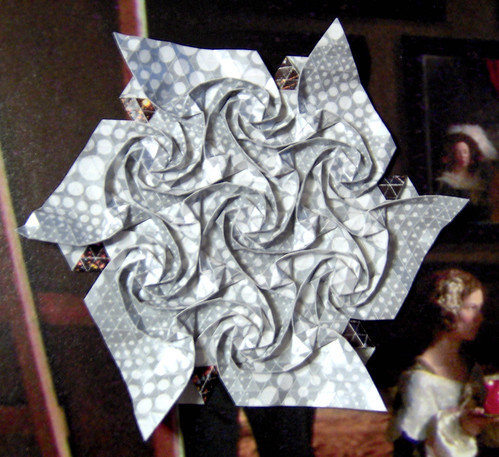
Tomoko Fuse revolutionised the art of origami. her pure talent led her to success in 1997 when she was awarded an award for artist of the year for her classic model, The Modular Star.

Unit Origami: Multidimensional Transformations, the English language edition of her seminal modular origami inventions, may be considered the classic text on modular origami available in the English language.
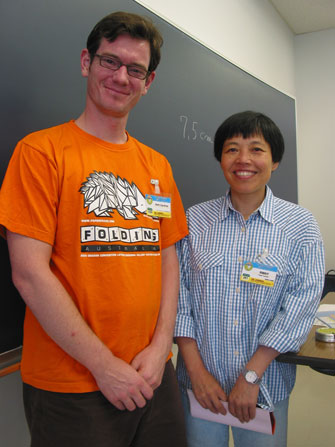
by vntopic
Nick Robinson

Nick Robinson is a practitioner of origami. He has been involved in the art since since the early 1980s and a member of the British Origami Society for nearly 25 years. He has contributed articles and designs for the magazine in almost every issue since 1987 and has served on their council for 15 years. He edited their bimonthly magazine for 5 years and maintains their web site. In 2004 he was awarded the “Sidney French medal” – the highest award the society can offer, in recognition of his contributions to origami. A prolific creator, his designs are usually simple and elegant, like those of his origami inspiration, Master Kunihiko Kasahara. He has had over 200 designs independently published in origami magazines and newspapers around the world.
Robinson spent several years as a professional origami teacher, travelling round schools, libraries, youth clubs, hospitals and art galleries, teaching origami and paper artwork. He ran sessions with people of all ages and physical abilities. He has been invited to teach and display his work in Switzerland, Italy, Germany, France and Japan. He has fulfilled numerous origami-based commissions for both national and international companies and has more conventional employment as an IT lecturer, web designer and author.
He has written and illustrated over twenty origami books, with total world-wide sales exceeding one million. Robinson is 50 and lives in Sheffield, England. A former professional musician, he played with an early version of Living In A Box and with the Comsat Angels . He was in a band with singer Harriet Roberts. He also played in an electronic jazz/rock group called Zyklus, led by the late Neil Ardley, until the untimely death of the latter. He still performs solo improvised ambient loopnig guitar concerts and recordings. He has co-ordinated several CD releases for the Chain Tape Collective group, including music made from the sound of paper and music made using bird song.
The 2007 short film "I Am Nick Robinson," about the meeting of two characters who share the same name, contains a reference to Robinson's artwork. The movie was featured in the short film competition at the 2007 SXSW Film Festival.

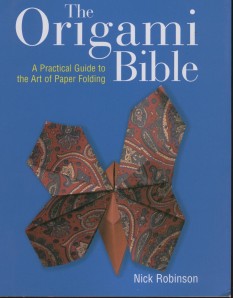
Further reading
Origami For Dummies Wiley & Co 2008 ISBN 978-0-470-75857-1
Picture Perfect Origami St. Martin's Griffin 2008 ISBN 978-0312375966
The Origami Giftbox Firefly Books 2006. ISBN 978-1-55407-198-2
A Beginners Guide to Origami Parragon Books, 2006. ISBN 1-40545-048-7
Encyclopedia of Origami Quarto Publishing 2005. ISBN 1-84448-025-9
Pub Origami New Holland Publishers 2005. ISBN 1-84330-935-1
Adult Origami New Holland Publishers 2004. ISBN 1-84330-744-8
The Origami Bible Collins & Brown 2004. ISBN 1-84340-105-3
Paper Planes that Really Fly Quintet Publishing 1992. ISBN 1-85076-325-9

Nick Robinson is a practitioner of origami. He has been involved in the art since since the early 1980s and a member of the British Origami Society for nearly 25 years. He has contributed articles and designs for the magazine in almost every issue since 1987 and has served on their council for 15 years. He edited their bimonthly magazine for 5 years and maintains their web site. In 2004 he was awarded the “Sidney French medal” – the highest award the society can offer, in recognition of his contributions to origami. A prolific creator, his designs are usually simple and elegant, like those of his origami inspiration, Master Kunihiko Kasahara. He has had over 200 designs independently published in origami magazines and newspapers around the world.
Robinson spent several years as a professional origami teacher, travelling round schools, libraries, youth clubs, hospitals and art galleries, teaching origami and paper artwork. He ran sessions with people of all ages and physical abilities. He has been invited to teach and display his work in Switzerland, Italy, Germany, France and Japan. He has fulfilled numerous origami-based commissions for both national and international companies and has more conventional employment as an IT lecturer, web designer and author.
He has written and illustrated over twenty origami books, with total world-wide sales exceeding one million. Robinson is 50 and lives in Sheffield, England. A former professional musician, he played with an early version of Living In A Box and with the Comsat Angels . He was in a band with singer Harriet Roberts. He also played in an electronic jazz/rock group called Zyklus, led by the late Neil Ardley, until the untimely death of the latter. He still performs solo improvised ambient loopnig guitar concerts and recordings. He has co-ordinated several CD releases for the Chain Tape Collective group, including music made from the sound of paper and music made using bird song.
The 2007 short film "I Am Nick Robinson," about the meeting of two characters who share the same name, contains a reference to Robinson's artwork. The movie was featured in the short film competition at the 2007 SXSW Film Festival.


Further reading
Origami For Dummies Wiley & Co 2008 ISBN 978-0-470-75857-1
Picture Perfect Origami St. Martin's Griffin 2008 ISBN 978-0312375966
The Origami Giftbox Firefly Books 2006. ISBN 978-1-55407-198-2
A Beginners Guide to Origami Parragon Books, 2006. ISBN 1-40545-048-7
Encyclopedia of Origami Quarto Publishing 2005. ISBN 1-84448-025-9
Pub Origami New Holland Publishers 2005. ISBN 1-84330-935-1
Adult Origami New Holland Publishers 2004. ISBN 1-84330-744-8
The Origami Bible Collins & Brown 2004. ISBN 1-84340-105-3
Paper Planes that Really Fly Quintet Publishing 1992. ISBN 1-85076-325-9
by vntopic
Dr. Robert J. Lang

Dr. Robert J. Lang 1961 (age 47–48) is an American physicist who is also one of the foremost origami artists and theorists in the world. He is known for his complex and elegant designs, most notably of insects and animals. He has long been a student of the mathematics of origami and of using computers to study the theories behind origami. He has made great advances in making real-world applications of origami to engineering problems.
Lang was born in Dayton, Ohio, and grew up in Atlanta, Georgia.Lang attended California Institute of Technology for his undergraduate work in electrical engineering, where he met his wife-to-be, Diane.He earned a Master's degree in electrical engineering from Stanford in 1983, and returned to Caltech to pursue a Ph.D. in Applied Physics with a dissertation titled “Semiconductor Lasers: New Geometries and Spectral Properties.”
Lang began work for NASA's Jet Propulsion Laboratory in 1988. Lang also worked as a research scientist for Spectra Diode Labs of San Jose, California, and then at JDS Uniphase, also of San Jose.
Lang has authored or co-authored over 80 publications on semiconductor lasers, optics, and integrated optoelectronics, and holds 46 patents in these fields.
In 2001, Lang left the engineering field to being a full-time origami artist and consultant.However, he still maintains ties to his physics background: he is the editor-in-chief of the Journal of Quantum Electronics and does part-time laser consulting for Cypress Semiconductor.
Lang currently resides in Alamo, California.
Lang was introduced to origami at the age of six by a teacher who had exhausted other methods of keeping him entertained in the classroom. By his early teens, he was designing original origami patterns.Lang used origami as an escape from the pressures of undergraduate studies. While studying at Caltech, Lang came into contact with other origami masters such as Michael LaFosse, John Montroll, Joseph Wu, and Paul Jackson through the Origami Center of America, now known as OrigamiUSA.
While in Germany for postdoctoral work, Lang and his wife were enamored of Black Forest cuckoo clocks, and he became a sensation in the origami world when he successfully folded one after three months of design and six hours of actual folding.
Lang takes full advantage of modern technology in his origami, including using a laser cutter to help score paper for complex folds.
Lang is recognized as one of the leading theorists of the mathematics of origami. He has developed ways to algorithmatize the design process for origami, and is the author of the proof of the completeness of the Huzita–Hatori axioms.
Lang specializes in finding real-world applications for the various theories of origami he has developed. These included designing folding patterns for a German airbag manufacturer. He has worked with the Lawrence Livermore National Laboratory in Livermore, California, where a team is developing a powerful space telescope, with a 100 m (328 ft) lens in the form of a thin membrane. Lang was engaged by the team to develop a way to fit the tremendous lens, known as the Eyeglass, into a small rocket in such a way that the lens can be unfolded in space and will not suffer from any permanent marks or creases.
Lang is the author or co-author of eight books and many articles on origami.
* The Complete Book of Origami - 1988
* Origami Zoo (with Stephen Weiss ) - 1989
* Origami Sea Life (with John Montroll) -1990
* Origami Animals - 1992
* Origami Insects and their Kin - 1995
* Origami in Action - 1996
* Origami Insects II - 2003
* Origami Design Secrets - 2003

Dr. Robert J. Lang 1961 (age 47–48) is an American physicist who is also one of the foremost origami artists and theorists in the world. He is known for his complex and elegant designs, most notably of insects and animals. He has long been a student of the mathematics of origami and of using computers to study the theories behind origami. He has made great advances in making real-world applications of origami to engineering problems.
Lang was born in Dayton, Ohio, and grew up in Atlanta, Georgia.Lang attended California Institute of Technology for his undergraduate work in electrical engineering, where he met his wife-to-be, Diane.He earned a Master's degree in electrical engineering from Stanford in 1983, and returned to Caltech to pursue a Ph.D. in Applied Physics with a dissertation titled “Semiconductor Lasers: New Geometries and Spectral Properties.”
Lang began work for NASA's Jet Propulsion Laboratory in 1988. Lang also worked as a research scientist for Spectra Diode Labs of San Jose, California, and then at JDS Uniphase, also of San Jose.
Lang has authored or co-authored over 80 publications on semiconductor lasers, optics, and integrated optoelectronics, and holds 46 patents in these fields.
In 2001, Lang left the engineering field to being a full-time origami artist and consultant.However, he still maintains ties to his physics background: he is the editor-in-chief of the Journal of Quantum Electronics and does part-time laser consulting for Cypress Semiconductor.
Lang currently resides in Alamo, California.
Lang was introduced to origami at the age of six by a teacher who had exhausted other methods of keeping him entertained in the classroom. By his early teens, he was designing original origami patterns.Lang used origami as an escape from the pressures of undergraduate studies. While studying at Caltech, Lang came into contact with other origami masters such as Michael LaFosse, John Montroll, Joseph Wu, and Paul Jackson through the Origami Center of America, now known as OrigamiUSA.
While in Germany for postdoctoral work, Lang and his wife were enamored of Black Forest cuckoo clocks, and he became a sensation in the origami world when he successfully folded one after three months of design and six hours of actual folding.
Lang takes full advantage of modern technology in his origami, including using a laser cutter to help score paper for complex folds.
Lang is recognized as one of the leading theorists of the mathematics of origami. He has developed ways to algorithmatize the design process for origami, and is the author of the proof of the completeness of the Huzita–Hatori axioms.
Lang specializes in finding real-world applications for the various theories of origami he has developed. These included designing folding patterns for a German airbag manufacturer. He has worked with the Lawrence Livermore National Laboratory in Livermore, California, where a team is developing a powerful space telescope, with a 100 m (328 ft) lens in the form of a thin membrane. Lang was engaged by the team to develop a way to fit the tremendous lens, known as the Eyeglass, into a small rocket in such a way that the lens can be unfolded in space and will not suffer from any permanent marks or creases.
Lang is the author or co-author of eight books and many articles on origami.
* The Complete Book of Origami - 1988
* Origami Zoo (with Stephen Weiss ) - 1989
* Origami Sea Life (with John Montroll) -1990
* Origami Animals - 1992
* Origami Insects and their Kin - 1995
* Origami in Action - 1996
* Origami Insects II - 2003
* Origami Design Secrets - 2003
by vntopic
Akira Yoshizawa (吉澤 章 Yoshizawa Akira; 14 March 1911 – 14 March 2005) was considered to be the grandmaster of origami. He is credited with raising origami from a craft to a living art. According to his own estimation made in 1989, he created more than 50,000 models, of which only a few hundred designs were diagrammed in his 18 books. Yoshizawa acted as an international cultural ambassador for Japan throughout his career. In 1983, Japanese emperor Hirohito named him to the Order of the Rising Sun, one of the most honorary awards that can be given to a Japanese citizen. 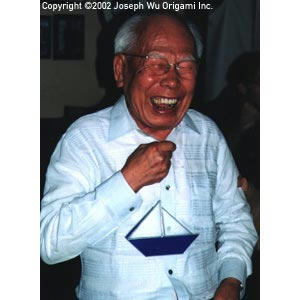 Photo by Joseph Wu Born on March 14th 1911, in Kaminokawa, Tochigi Prefecture, Japan, to the family of a dairy farmer. When a child, he took pleasure in teaching himself origami. He moved into a factory job in Tokyo when he was 13 years old. His passion for it was rekindled in his early 20’s, when he was promoted from factory worker to technical draftsman. His new job was to teach junior employees geometry. Yoshizawa used the traditional art of origami to understand and communicate geometrical problems. In 1937 he left factory work to pursue origami full-time. During the next 20 years, he lived in total poverty, earning his living by door-to-door selling of tsukudani (a kind of Japanese soup made of soy sauce and seafood). His origami work was creative enough to be included in the 1944 book Origami Shuko, by Isao Honda (本多 功). However it was his work for a 1951 issue of the magazine Asahi Graph that launched his career (according to another account, his first step on the professional road was a set of 12 zodiac signs commissioned by a magazine in 1954). In 1954 his first published monograph, Atarashi Origami Geijutsu (New Origami Art) was published. In this work he established the Yoshizawa-Randlett system of notation for origami folds which has become the standard for most paperfolders. The publishing of this book helped Yoshizawa out of his poverty. It was followed closely by his founding of the International Origami Centre in Tokyo (1954, when he was 43 years of age). His first overseas exhibition was organised in 1955 by Felix Tikotin, a Dutch architect and art collector of German Jewish origin, in the Stedelijk Museum. Yoshizawa lent many of his own origami models to other exhibitions around the world. He would never sell his origami figures, but rather gave them away as gifts to people, and let other groups and organizations borrow them for exhibiting. In 1956, he married a woman named Kiyo, who acted as his manager and taught origami alongside him. It was around this time that he became famous worldwide. Yoshizawa pioneered many techniques, including wet-folding. In this technique the paper is dampened before folding, letting the folder create a much more rounded and sculpted look. This was considered by many to be the paradigm shift of sorts that allowed origami to become an artform, as opposed to a quaint oddity of folklore. His famous Gorilla, which has a very primitive, deeply creased face, was created by wet folding. 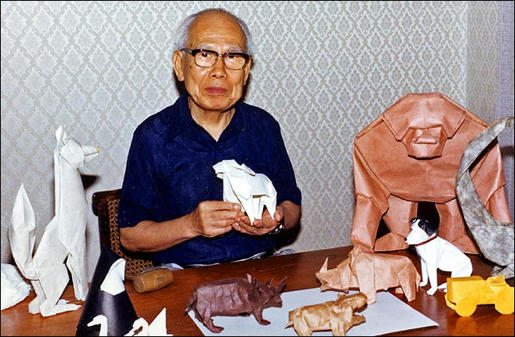 In March 1998, Yoshizawa was invited to exhibit his origami, in what still remains the greatest origami exhibition ever staged, in the Louvre museum. He did it so joyfully, and was not at all opposed to having his photo taken with other competing origami artists, whom he used to detest in his earlier years; many of his patterns were diagrammed by his professional rivals, which angered Yoshizawa when he was younger. However, he found that he was no longer so repulsed by rival origami folders, and that, in fact, he now enjoyed their company. Akira Yoshizawa died on March 14, 2005 in hospital in Ogikubo, of complications of pneumonia, on his 94th birthday.  |
by vntopic
|
Name | Kamiya Satoshi | |
| Birthday & Place | June 6, 1981, in Nagoya, Japan | ||
| Homepage | http://www.folders.jp/ | ||
| Some Infomation | He began the art at age two, and began seriously designing more advanced models in 1995, and has since made hundreds of origami models.[1] Perhaps his most famous design is Ryujin 3.5, an elaborate dragon covered with scales and having a mustache, claws, and horns. The work can take up to one month to fold properly.[2] Satoshi has drawn inspiration for his designs from Manga, nature, and both eastern and western mythologies. | ||
| Books | Collection Book by Author | ||
| Models | Collection Models by Author | ||
| Exhibiton & Gallery | Exhibiton & Gallery of the Author |
From Wikipedia, the free encyclopedia
Satoshi Kamiya (?? ?? Kamiya Satoshi?, born June 6, 1981, in Nagoya, Japan) is among the most advanced origami masters in the world. He began the art at age two, and began seriously designing more advanced models in 1995, and has since made hundreds of origami models.[1] Perhaps his most famous design is Ryujin 3.5, an elaborate dragon covered with scales and having a mustache, claws, and horns. The work can take up to one month to fold properly.[2] Satoshi has drawn inspiration for his designs from Manga, nature, and both eastern and western mythologies.Many of Satoshi's origami designs are exceptionally complex; the dragons require around 275 steps each and need to be made from at least 20" squares of thin paper or foil. Another of his more notable models is a feathered, long-tailed phoenix. The dragon model is unique, however, in that the crease pattern is asymmetrical yet produces a symmetrical model. Kamiya has written one book, which includes diagrams of nineteen models of intermediate through complex difficulty.
Subscribe to NewsLetter
Get the latest updates via EmailService provided by FeedBurner
Search This Blog
Catelogy
- 3D Origami (14)
- Book by Tanteidan Convention (16)
- Book-eBooks (353)
- Collection CP Satoshi Kamiya (17)
- Collection Diagram Sipho Mabona (1)
- Collection Diagram by BRIAN CHAN (9)
- Collection Diagram by Ekaterina Lukasheva (13)
- Collection Diagram by HOJYO TAKASHI (18)
- Collection Diagram by Halle (18)
- Collection Diagram by Issei Yoshino (14)
- Collection Diagram by Komatsu Hideo (24)
- Collection Diagram by Manuel Sirgo Alvarez (54)
- Collection Diagram by NguyenHungCuong (8)
- Collection Diagram by Robert J.Lang (68)
- Collection Diagram by Roman Diaz (21)
- Collection Diagram by Satoshi Kamiya (48)
- Diagram of Cartoon Origami 1 (10)
- Diagram of Cartoon Origami 2 (8)
- Diagram of Imaginando en papel (21)
- Diagram of Issei Super Complex Origami (14)
- Diagram of LICENCE TO FOLD (19)
- Diagram of Origami Insect II (16)
- Diagram of Origami for Interpreters (19)
- Diagram of Papiroinsectos y otros origamis exóticos (30)
- Diagram of Tanteidan Convention 14 (15)
- Diagram of Tanteidan Convention 15 (25)
- Diagram of Tanteidan Convention 16 (4)
- Diagram of The complete book of origami (35)
- Diagram of Works of Satoshi KAMIYA 1995-2003 (19)
- Diagram of World of Super Complex Origami (4)
- Diagrams of Origami Sea Life (15)
- Modular Origami (19)
- Origami Animals Diagrams (138)
- Origami Authors (6)
- Origami Bird Diagrams (28)
- Origami Book 2010 (4)
- Origami Book by Halle (3)
- Origami Book by Manuel Sirgo Alvarez (2)
- Origami Book by Robert J.Lang (10)
- Origami Book by Satoshi Kamiya (4)
- Origami Book of Meenakshi Mukerji (2)
- Origami Book-eBooks (30)
- Origami Butterfly Diagrams (4)
- Origami CP (16)
- Origami Cartoon Diagrams (23)
- Origami Complex Diagram (6)
- Origami Diagram (319)
- Origami Dinosaur Diagrams (18)
- Origami Dragon Diagrams (26)
- Origami FANTASY Diagrams (39)
- Origami Fish Diagrams (23)
- Origami Flower Diagrams (10)
- Origami HORSE Diagrams (9)
- Origami Human Diagrams (19)
- Origami Insect Diagrams (71)
- Origami Intermediate Diagram (25)
- Origami Kusudama Diagrams (16)
- Origami Mask Diagrams (4)
- Origami Object Diagrams (13)
- Origami Sea-Water Diagrams (26)
- Origami Simple Diagram (8)
- Origami Super Complex (4)
- Origami Swan Diagrams (4)
- Origami book by Tomoko Fuse (89)
Blog Archive
-
►
2010
(836)
-
►
September
(415)
-
►
Sep 01
(30)
- SONG BIRD - R.J.Lang
- SHARK - R.J.Lang
- SCORPION - R.J.Lang
- SEATED LADY - R.J.Lang
- PIANIST - R.J.Lang
- PEGASUS - R.J.Lang
- PARROT - R.J.Lang
- NUN - R.J.Lang
- KING TUT - R.J.Lang
- GRASSHOPPER - R.J.Lang
- KANGAROO - R.J.Lang
- GERBIL - R.J.Lang
- FISH - R.J.Lang
- ELEPHANT - R.J.Lang
- DRAGON FLY - R.J.Lang
- DIMETRODON - R.J.Lang
- DEER - R.J.Lang
- CUCKOO CLOCK - R.J.Lang
- CICADA - R.J.Lang
- Cap - R.J.Lang
- BIPLANE - R.J.Lang
- BASSIST - R.J.Lang
- BALD EAGLE - R.J.Lang
- The complete book of origami-By Robert J. Lang
- Yoshihide Momotani
- Tomoko Fuse
- Nick Robinson
- Dr. Robert J. Lang
- Akira Yoshizawa
- Satoshi Kamiya - Origami Authors
-
►
Sep 01
(30)
-
►
September
(415)
